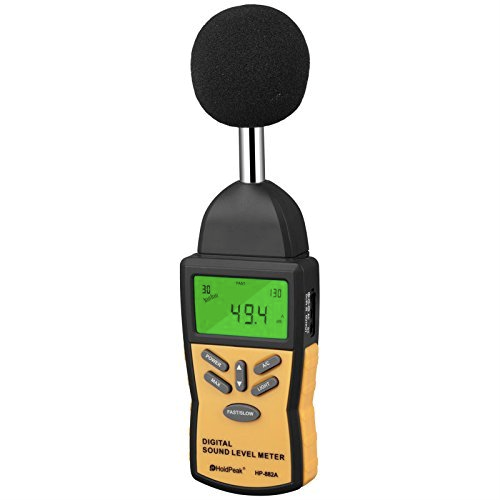A sound-measuring instrument, also known as a sound level meter or decibel meter, is used to measure and quantify the intensity or level of sound in a given environment. It is essential in environmental monitoring, industrial hygiene, occupational safety, and architectural acoustics. The instrument detects, and measures sound pressure levels, allowing for the evaluation of noise levels and compliance with regulatory standards.
A sound-measuring instrument typically consists of a microphone, an amplifier, filters, and a display unit. The microphone converts sound waves into electrical signals, which are then amplified and processed by the instrument’s circuitry. The filters adjust the instrument’s frequency response to match human hearing characteristics, as different frequencies can impact human perception and health differently.
The most common parameter measured by sound-measuring instruments is the sound pressure level (SPL), expressed in decibels (dB). The decibel scale is logarithmic and represents the ratio between the measured sound pressure and a reference level. This scale represents various sound intensities, from the faintest audible to extremely loud noises.
Sound measuring instruments often provide additional parameters such as frequency weighting and time weighting. Frequency weighting adjusts the instrument’s response to different frequencies based on human perception. The most commonly used frequency weightings are A-weighting (dBA) and C-weighting (dBC). A-weighting is used for general noise measurements, while C-weighting is employed in situations where low-frequency noise is a concern, such as industrial settings. Time weighting adjusts the instrument’s response to different sound durations, with the most common settings being fast (F) and slow (S). Fast-time weighting provides a near-instantaneous reading, while slow-time weighting averages the sound level over a longer period, providing a more stable measurement.
Sound-measuring instruments can also feature various functionalities and capabilities. Some instruments offer data logging, allowing for continuous monitoring of noise levels over time. This is particularly useful for assessing the variations in noise levels in different locations or periods. Many modern instruments can store and analyze data, providing statistical information such as maximum, minimum, and average sound levels.
Sound measuring instruments play a vital role in assessing and mitigating the impact of noise on human health and the environment. They are widely used in various applications, including occupational noise monitoring, environmental noise surveys, building acoustics, and sound product testing. By accurately measuring and documenting noise levels, these instruments help ensure compliance with regulatory standards and enable the implementation of appropriate noise control measures.
In addition to the basic functions and parameters mentioned earlier, there are several other aspects and features worth exploring when it comes to noise-measuring instruments. Let’s dig deeper into some aspects:
- Integration Time: sound measuring instruments often provide options for adjusting the integration time or measurement duration. This feature determines how long the instrument takes to calculate and display the sound level. Short integration times, such as the impulse or peak mode, capture rapid changes in sound levels, while longer integration times, such as the equivalent or Leq mode, provide a more comprehensive average measurement over a specific period.
- Data Logging and Memory: Many sound measuring instruments have data logging capabilities, allowing them to record sound level measurements at regular intervals. This feature enables users to collect data over extended periods, facilitating trend analysis and long-term monitoring. The instruments may have built-in memory or support external storage options like SD cards or USB drives to store and retrieve the recorded data.
- Frequency Analysis: Advanced sound measuring instruments can perform frequency analysis, providing information about the sound energy distribution across different frequency bands. This capability is particularly useful in acoustic engineering, architectural design, and industrial noise control applications. Spectral data allows a more detailed assessment of noise sources and identifies specific frequency components contributing to the overall sound.
- Real-Time Analysis: Some sound-measuring instruments offer real-time analysis features that provide instant feedback on sound levels and frequency content. These instruments typically display a graph or spectrogram of the sound, allowing users to visualize changes in noise levels over time. Real-time analysis can assist in identifying noise patterns, locating noise sources, and evaluating the effectiveness of noise control measures.
Sound measuring instruments are devices used to measure and analyze sound levels in various applications. Some common types include sound level meters, integrating sound level meters, real-time analyzers, FFT analyzers, vibration meters, sound intensity probes, noise dosimeters, and environmental noise monitoring systems.
Sound level meters are portable devices that measure the intensity or level of sound. Integrating sound level meters provide cumulative measurements over time, such as equivalent sound level. Real-time and FFT analyzers provide detailed frequency analysis of sound signals, allowing for a comprehensive understanding of sound spectra. Vibration meters measure vibrations caused by a sound or other sources, while sound intensity probes determine sound power levels and source localization.
Noise dosimeters are personal instruments worn to measure personal noise exposure. Environmental noise monitoring systems consist of multiple sound level meters placed in various locations to monitor ambient noise levels.
These instruments are used in various fields, including environmental monitoring, occupational health and safety, architectural acoustics, industrial noise control, and audio engineering. They help ensure compliance with regulations, assess noise impact, identify noise sources, and facilitate effective noise control strategies. With continuous technological advancements, sound measuring instruments remain essential for maintaining acoustically optimized environments.
In conclusion, sound-measuring instruments play a vital role in quantifying, analyzing, and controlling sound levels in various applications. From basic sound level meters to advanced analyzers and specialized probes, these instruments enable accurate measurements, compliance with regulations, and effective noise control strategies. The continuous development of sound measuring technology ensures that these instruments remain essential tools in maintaining healthy and acoustically optimized environments.






